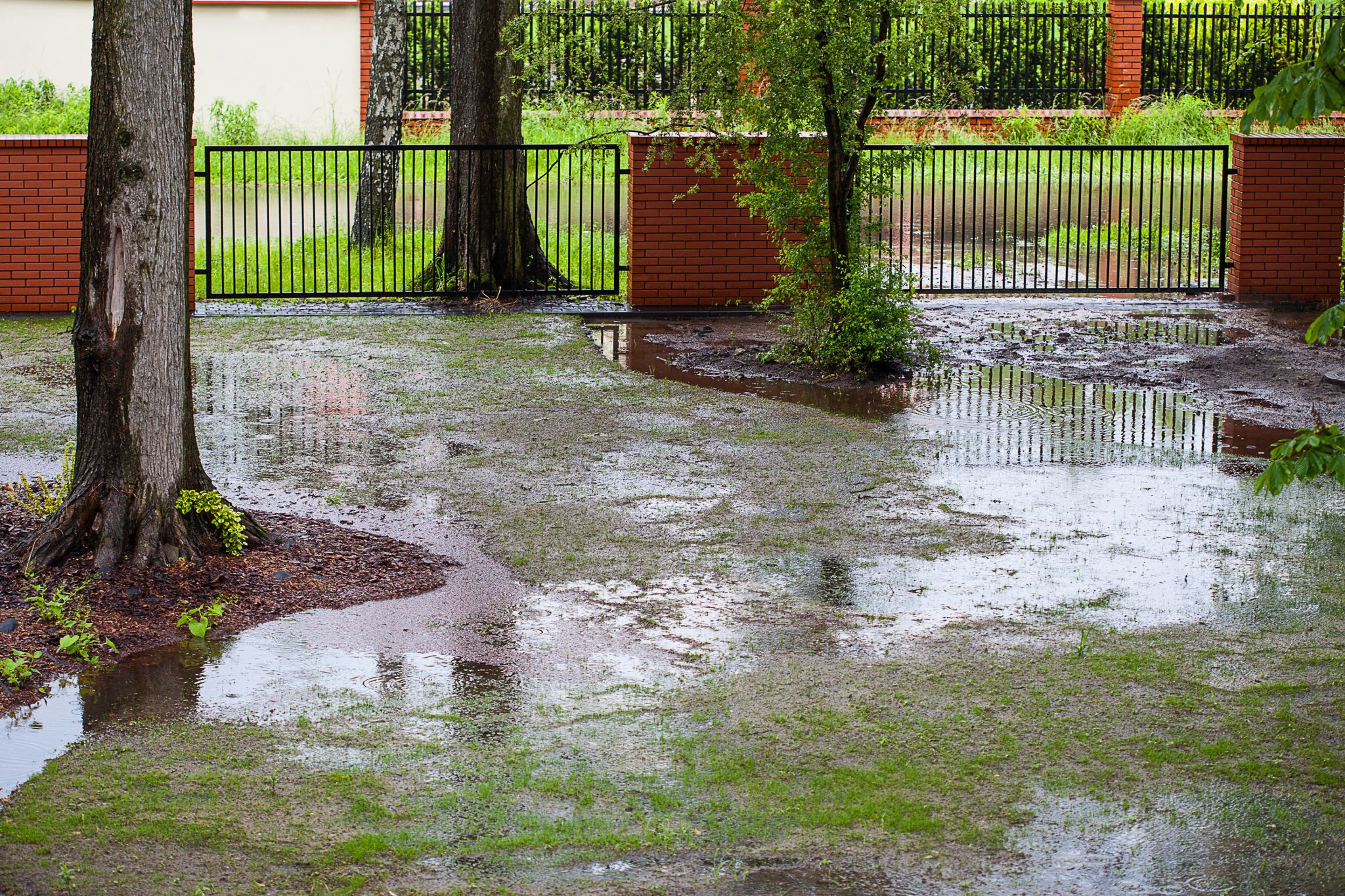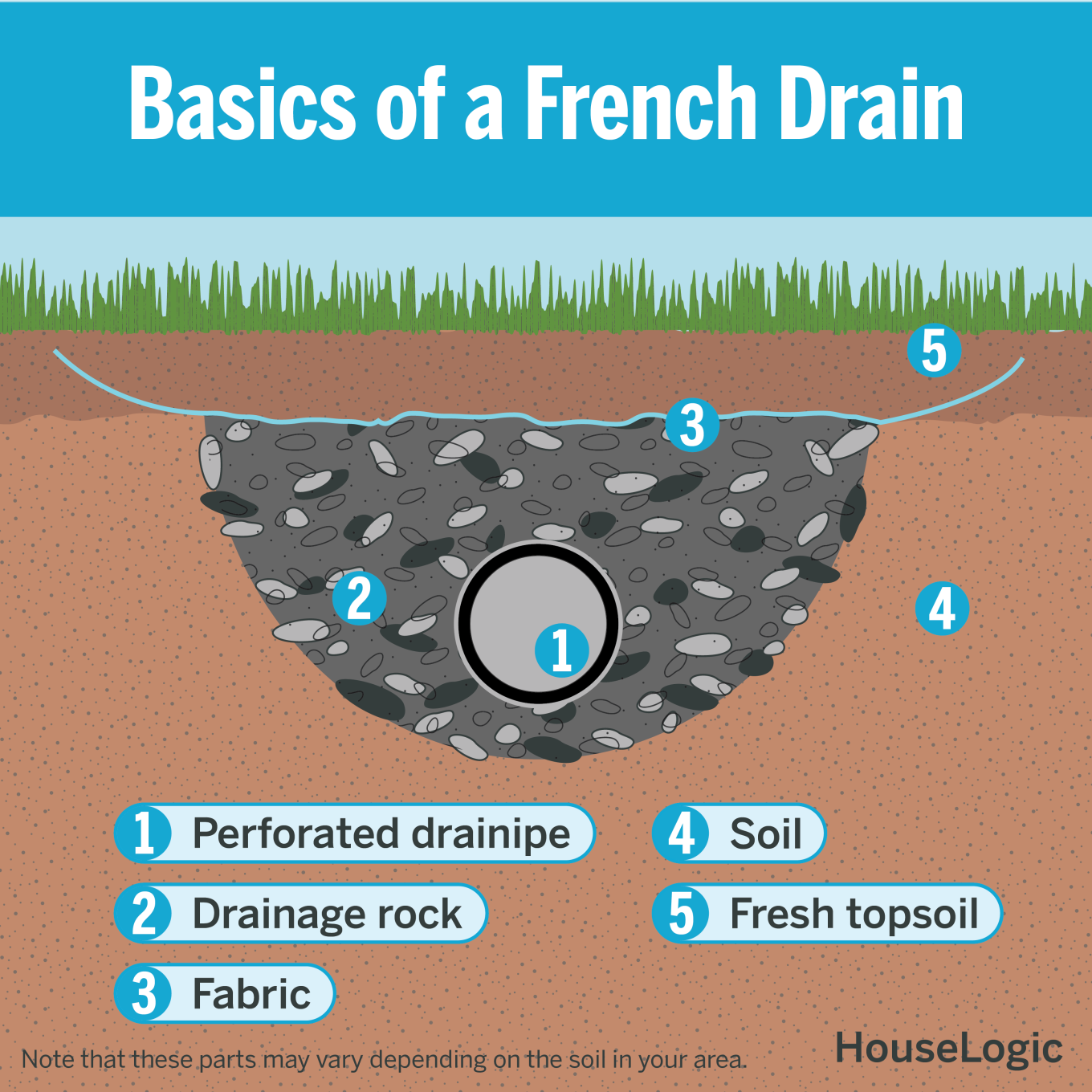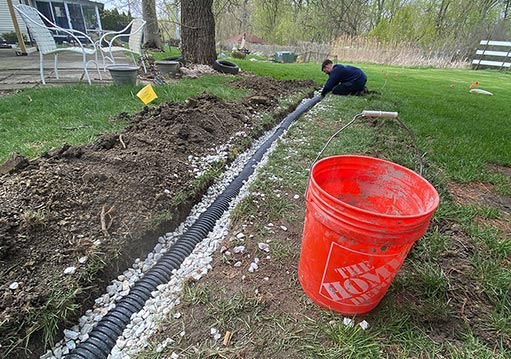Understanding the Benefits and Installation Process of a French Drainpipe for Property Owners
A French drain can be the option you require if you're dealing with water pooling around your home. It redirects excess moisture far from your foundation, helping to avoid expensive damage and mold issues. Before you leap right into installation, it's essential to comprehend the advantages and the actions entailed. Allow's discover exactly how to examine your residential property and what devices you'll need to get started.
What Is a French Drain?
A French drainpipe is an effective solution for managing excess water in your backyard. It's a trench loaded with crushed rock or rock that has a perforated pipeline at its base. This design permits water to flow right into the pipeline rather of pooling around your home, stopping flooding and erosion. When you see water gathering in particular locations, a French drainpipe can redirect that moisture far from your foundation and other crucial areas.Installing one entails excavating a trench that slopes away from your home, guaranteeing reliable water drain. You'll need to line the trench with landscape textile to stop soil from clogging the crushed rock. Once you've positioned the pipe and covered it with crushed rock, the system will successfully carry water away. This basic yet effective drain option can aid secure your building from water damage and keep the stability of your landscape.

Key Advantages of Mounting a French Drainpipe
Setting up a French drainpipe can significantly enhance your home's drainage system, particularly if you typically manage water pooling in your yard. Among the essential benefits is that it efficiently reroutes excess water away from your home's structure, minimizing the risk of water damages and mold development. This can conserve you from pricey repairs down the line.Additionally, a French drainpipe can improve your yard's overall appearances by preventing unpleasant puddles and muddy locations. With better water drainage, you can delight in a more usable exterior space for tasks and gardening.Moreover, these drains pipes can raise your property's worth. Prospective customers appreciate a well-drained lawn, as it suggests much less upkeep and less problems. French drains call for marginal maintenance-- just periodic cleaning to ensure they work effectively. By investing in a French drainpipe, you're making a wise choice for both your home and your peace of mind.
Analyzing Your Residential Or Commercial Property for Drain Issues
Prior to you can successfully address drainage concerns, it's vital to assess your residential or commercial property thoroughly. Beginning by walking your yard after a hefty rain to identify trouble areas. Try to find standing water, soggy spots, or erosion, as these signs indicate bad drainage. Focus on just how water streams on your residential property; observe if it collects near your foundation or in low-lying areas.Next, check your gutters and downspouts. Verify they straight water far from your home which they're without debris. Check your landscaping, as particular plants can add to water drainage problems by soaking up also much water or creating barriers.Finally, think about the slope of your backyard. Preferably, your land ought to incline far from your structure. If you notice any kind of problems, take notes; this will certainly assist you establish the very best water drainage solutions, like mounting a French drain, later on.

Tools and Materials Needed for Setup
As soon as you have actually recognized the water drainage concerns on your home, gathering the right tools and materials for a French drainpipe setup becomes the next action. You'll need a shovel or trenching tool to dig the trench for your drainpipe. A degree will certainly aid assure the trench inclines properly, advertising appropriate water flow.For materials, purchase perforated PVC pipeline to allow water to get in while maintaining out soil. You'll likewise need crushed rock to surround the pipe, aiding drainage and avoiding obstructing. Landscape design textile is important to maintain dirt out of the gravel and pipe.Don' t fail to remember security equipment like gloves and safety glasses for security while you function. Guarantee you have the essential installations and a pump on hand if you plan to connect your French drain to a sump pump. With these materials and devices, you'll be ready to tackle your French drainpipe installation properly.
Step-by-Step Setup Process
Now that you have actually collected your tools and products, it's time to get started on mounting your French drainpipe (Portland French Drain). You'll need to concentrate on trenching and appropriate drainpipe placement to ensure reliable water management. Ultimately, backfilling and completing the last actions will complete your task nicely
Required Equipments and Materials
To effectively mount a French drain, you'll require a couple of essential tools and products at your disposal. Begin with a shovel or a trenching device to dig your trench. A degree's essential for ensuring proper incline, while a tape step assists you evaluate distances precisely. You'll additionally need perforated pipeline, which is the heart of the system, and crushed rock or rock for drainage. A landscape material will prevent soil from clogging the drainpipe. Do not forget a wheelbarrow for transporting materials and safety and security equipment like gloves and safety glasses. A pickaxe can be useful for breaking up tough dirt. Collect these products before you start, and you'll be established for a smooth installment procedure.
Trenching and Drain Positioning
As you prepare to mount your French drainpipe, the initial step entails meticulously digging the trench where the drainpipe will be put. Begin by noting the desired path with spray paint or string, ensuring it has an incline of at the very least 1% for proper drain. Utilizing a shovel or trenching tool, dig a trench about 6 inches vast and 18 to 24 inches deep. Get rid of any kind of rocks, roots, or debris as you go. Once the trench prepares, line it with landscape design material to avoid soil from clogging the drainpipe. Next, put a layer of gravel at the bottom for water drainage support. Ultimately, place the perforated drain pipe click in the trench with the openings encountering down, guaranteeing it's aligned with the slope for perfect water flow.
Backfilling and Last Steps
It's time to backfill the trench when you have actually put the perforated drainpipe pipeline and covered it with gravel. Begin by including a layer of soil on top of the crushed rock, seeing to it to stay clear of large globs or rocks. Rake or utilize a shovel to equally disperse the soil, filling up the trench to the surface degree. It's crucial to small the dirt lightly as you go to prevent future settling. After backfilling, smooth out the surface, mixing it effortlessly with the surrounding area. Think about including topsoil for far better growth if you're intending to plant yard or other greenery. Finally, check for any type of water drainage issues, and tidy up your workspace, making certain whatever looks neat and useful.

Maintenance Tips for Your French Drainpipe
While maintaining your French drain might seem difficult, click for more it's crucial for protecting against water accumulation and guaranteeing efficient water drainage. Initially, on a regular basis inspect the drainpipe's outlet for debris like fallen leaves, dust, or various other obstructions. If you notice a blockage, clear it out without delay to stay clear of backups (Portland French Drain).Next, examine the crushed rock bordering the drainpipe. If you see a substantial amount of sediment buildup, take into consideration cleansing or replacing the gravel to preserve peak performance.Additionally, keep an eye on the location around your French drainpipe for indications of erosion or settling. If you find any issues, take activity to repair them, as they can influence water drainage efficiency.Lastly, take into consideration evaluating the drainpipe's efficiency after heavy rainfall. If water pools nearby, it could be time to reassess your system. By following these maintenance pointers, you'll ensure your French drainpipe remains to operate effectively and safeguards your home from water damage
When to Call a Professional for Aid
You need to think about calling a specialist if you notice signs of drain issues, like persistent standing water or overflowing rain gutters. Complex installment demands can additionally signify that it's time to get expert aid, specifically if you're unsure regarding local safety and security regulations. Do not think twice to connect for aid to assure your French drainpipe functions properly and satisfies code.
Indications of Drain Issues
When drainpipe issues occur, recognizing the indicators early can save you from pricey fixings down the line. Try to find water pooling in your lawn or around your structure; this could indicate an obstruction. If you notice consistent moisture in your basement, it's a sure indicator that drain isn't functioning effectively. Maintain an eye out for foul smells, which can stem from stagnant water or decomposing debris in the drain. You could hear uncommon gurgling sounds from your pipes, suggesting a clog in the system. Finally, if you identify erosion or sinking dirt, it's time to act. Don't hesitate to call an expert to examine the scenario and prevent additional damages to your home.
Complex Installment Needs
If you're considering installing a French drainpipe, comprehending the complicated setup demands is necessary for guaranteeing its effectiveness. French drains usually include excavation, sloping, and proper water drainage products, which can be overwhelming. It's smart to call an expert if your yard has challenging terrain or you're unclear regarding regional dirt conditions. They can evaluate your home and identify the finest technique. Furthermore, if you lack the necessary tools or experience, hiring a specialist can conserve you time and tension. An expert can also ensure the drainpipe is set up to work correctly and last for several years. Eventually, buying specialist assistance can prevent pricey blunders and assure your French drain runs efficiently.
Safety And Security and Rules Compliance
While preparing your French drain installation, it's essential to focus on safety and security and adhere to neighborhood policies. Prior to you start excavating, check if you require a license or if there specify codes in your area. This assures you're not breaking any kind of laws that can result in fines or job delays.If you're unsure regarding below ground energies, call a professional to situate them. It's important to stay clear of destructive gas, water, or electric lines. Additionally, if the installation requires hefty machinery or challenging grading, employing a contractor can save you effort and time. Keep in mind, safety and security precedes-- more info here don't be reluctant to look for assistance if you really feel overloaded or unsure regarding the procedure. Doing so safeguards your home and ensures an effective drainage service.
Often Asked Questions
Can a French Drainpipe Assist With Basement Flooding Problems?
Yes, a French drainpipe can efficiently reroute water away from your basement, decreasing flooding issues. By setting up one, you'll handle excess water far better and shield your home from prospective water damage and mold growth.
For how long Does a French Drain Commonly Last?
A French drainpipe typically lasts around 30 to 40 years, depending on the materials utilized and maintenance - Portland French Drain. Regular inspections and appropriate care can help extend its life-span, ensuring reliable water drainage for your property
Are There Alternatives to a French Drainpipe?
Yes, there are options to a French drain. You could consider surface drains pipes, completely dry wells, or grading your yard to redirect water. Each alternative has different effectiveness, so evaluate your specific water drainage requires before choosing.
Will a French Drainpipe Influence My Residential or commercial property's Landscape?
A French drainpipe can modify your building's landscape by rerouting water flow and possibly altering soil dampness levels. With careful planning, you can maintain appearances while enhancing water drainage and avoiding water damages.
Can I Install a French Drain in Wintertime?
Yes, you can mount a French drainpipe in wintertime, but you'll need to consider icy ground conditions. Make sure you have actually the right tools and products to handle any obstacles positioned by the winter. When you observe water accumulating in particular areas, a French drain can reroute that moisture away from your structure and various other vital areas.Installing one entails excavating a trench that slopes away from your home, making certain efficient water drainage. Setting up a French drain can greatly enhance your residential or commercial property's drain system, particularly if you often deal with water pooling in your lawn. As you prepare to mount your French drain, the initial step involves thoroughly digging the trench where the drain will be put. While preserving your French drain might seem difficult, it's important for avoiding water accumulation and guaranteeing efficient water drainage. A French drainpipe can modify your residential property's landscape by rerouting water circulation and possibly altering dirt dampness degrees.